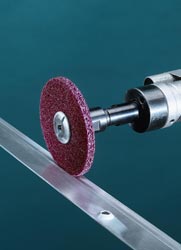
Posted to News on 4th Jul 2011, 13:00
Abrasives add value when cleaning and finishing metal surfaces
Nigel Willcock, of the Abrasive Systems Division at 3M United Kingdom, explains the value-adding role of abrasives in the cleaning and finishing of metal surfaces.

Removing metal surface contamination is integral to the quality of subsequent processes, such as phosphating, painting, powder coating or welding, and so to final product appearance. Oil, grease, rust, sealants, adhesives, paints, coatings and dust can all create problems if not removed.
If left unchecked, contamination can also build up within the surface layer as various compounds and elements migrate to the surface during manufacture. This can lead to corrosion and other problems, and adversely affect service life.
Even microscopic burrs can allow dirt and moisture build-up, reducing the chance of a high-quality finish being achieved.
Make the right choice
An incorrect choice of cleaning and finishing products can create inconsistent finishes, excessive stock removal and serious scratching with the final finishing stage - which is then more concerned with rectification. Similarly, using products whose finish is inconsistent, like polishing mops and low-quality belts, can deliver a poor-quality finish that is unreceptive to further treatments.
Meanwhile, coated abrasives, wire brushes, wheels and some other finishing tools can, if used incorrectly, introduce harmful tensile stresses into the metal surface - which may lead to cracking or fatigue. However, scratch patterns introduced by modern abrasives - particularly non-woven products - can induce beneficial competitive stresses that reverse tensile stress effects.
The right abrasive cleaning can also enhance surface properties by increasing the metal's true surface area, in turn improving adhesion of subsequently applied coatings.
Welding and bonding
Meanwhile, on aluminium alloys, abrasives have been shown to deliver a thinner oxide layer than with chemical etching - thereby reducing electrical resistance and improving weldability. Abrasive treatment has also been shown to be highly effective as a pretreatment to abrasive bonding, with greater bonding strength achievable.
Modern abrasives' conformability gives them a controlled cutting edge and the ability to more closely follow surface contours, thereby removing only surface contaminants and negligible substrate material.
Abrasive product selection ultimately depends on which can best remove contaminants without damaging the underlying surface.
For example, non-woven abrasives are particularly well adapted to removing the surface carbon layer from steel. With steel, these abrasives can also produce uniform and chemically similar surfaces. Uniform cleanliness of the abraded surface also enhances steel's reactivity to phosphate treatments applied to improve corrosion resistance.
Product specification
For aggressive cleaning, a fibre disc angle grinder fitted with various discs and a suitable back-up pad can be both portable and versatile. Fibre discs offer the best below-surface stock removal, and non-woven surface conditioning discs are best for light-duty cleaning. These products offer reduced risk of gouging or undercutting, meaning less rework is needed.
For greater conformability, a modern alternative to wire brushes that can be fitted to an angle grinder is a one-piece moulded disc, impregnated with mineral, delivering more consistent cleaning than wire brushes throughout the product's life. This product's construction also eliminates the risk of flying wires associated with wire brushes, making it far safer, while minimal pressure is required.
For larger workpieces where the tool is brought to the job, a straight grinder system can also be used, with discs selected depending on whether the need is for surface or sub-surface cleaning.
For detailed work, mini-grinder systems are versatile, providing greater access to the workpiece compared with conventional disc attachments. A comprehensive variety of mini discs is available, from specialist coating-removal discs to unitised discs designed for tasks including blue weld removal, where they can replace hazardous acid-based systems. Unitised discs can also deliver a bright satin finish.
Backstands and linishers
An alternative for processing small parts, particularly where volumes are higher, is a backstand or linisher. As the part is taken to the belt, these systems offer greater control, which is a particular benefit when complex parts are involved. Again, consumable choice depends on the type of treatment needed; cloth belts remove heavy scale and pitting, while non-woven surface conditioning belts offer soft-edge cleaning without altering the base metal's dimension. For hard-to-reach areas, options include a file belt tool with a range of contact arms, and a portable flexible-shaft machine. The latter can be fitted with: heavy-duty discs for rapid cleaning; radial brushes, which are excellent for removal of weld blueing due to their conformability; and unitised wheels for a bright satin finish.
Finally, for cleaning flat accessible areas, specialist systems exist that can be fitted with brushes or belts to provide a complete system for cleaning, graining and finishing.
From these examples, it can be clearly seen that the range and versatility of modern abrasive tools and consumables can potentially consign more cumbersome, inaccurate and potentially dangerous processes to the past. Given the productivity and quality advantages achievable with modern abrasives, cleaning and finishing has moved a long way from its previous rectification role to become a key value-adding process stage.
For further information about how abrasives add value when cleaning and finishing metal surfaces, go to www.3M.co.uk/abrasives.
Want the latest machine building news straight to your inbox? Become a MachineBuilding member for free today >>
3M United Kingdom Plc (Abrasives Systems Division)
3M Centre
Cain Road
RG12 8HT
UNITED KINGDOM
44 8705 360 036

















